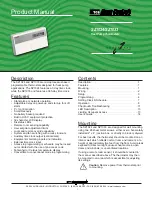
2800 LAURA LANE • MIDDLETON, WI 53562 • (800) 288-9383 • FAX (608) 836-9044 • www.tcsbasys.com
10
the thermostat to fit your equipment to the building load.
The offset value is the amount away from the setpoint
a stage will turn off. By assigning a stage a value other
than zero, you “anticipate” that the residual heat or cool-
ing in the duct or the other stages will bring the tempera-
ture back to setpoint. In most cases, the first stage is set
to zero. The differential value is the difference between
the on and off points. This value depends on the load
and on the equipment size. If the equipment is large for
the load, you may want to make this value as high as 5
to prevent equipment cycling. If the equipment is small
compared to the load, or if tight control is desired, you
may want to make this value as low as 1.
The fact that the stages are configurable allows unused
stages to be set to activate physical alarms if desired.
In summary, unlike most other multi-stage program-
mable thermostats, the Superstat allows independent
adjustments of "offsets" and "differentials" for stages of
heating and cooling. The offset settings can be viewed
as setpoints for the second and third stages and are pro-
grammed in the Superstat in the number of degrees (i.e.
1,2,3…) beyond the heating and cooling setpoints (tem-
peratures to be maintained).
The differential for each stage can be viewed as the
"anticipator" function used in mechanical thermostats.
P + I OPTION
The SZ1024 and SZ1033 also have a P+I option. Without
enabling this option, stages turn on and off based on
temperature vs. setpoint alone, as described above. By
enabling this option, you allow a time factor to be added.
This is useful when you are forced to have a large differ-
ential due to equipment size. At times when the building
load is low, the temperature could potentially sit a few
degrees off setpoint for some time. With the time factor
added, the thermostat would compensate for this, turning
on the equipment even though the temperature had not
reached the limits described above.
DI2 COOL LOCKOUT
DI2 may be set as cool lockout for operation with econo-
mizers. An outdoor temperature switch may be wired in
such that when DI2 is closed, the second stage of cool-
ing is disabled.
SMART RECOVERY
“Smart Recovery” may be enabled to insure occupant
comfort while saving money. It takes the building load
into consideration and ramps the setpoint when going
from the unoccupied mode to the occupied mode. At the
beginning of the occupied mode, the occupied setpoint
will be reached, many times without the need for the
second stage to come on. This feature is automatically
disabled when DI3 is set to external time clock.
AUXILIARY OUTPUT
An auxiliary relay output is available to output a signal
based on the occupancy status. It is commonly used with
an economizer minimum position control, or to signal an
outdoor air damper to open in occupied times in lieu of an
economizer. It may also be used for lighting or hot water
heaters. Keep in mind that although it is an isolated relay
(separate common terminal), it is rated at 24 VAC. For
loads that exceed this, use an external relay. It may be
set to be open (NO) or closed (NC) when the thermostat
is operating in the occupied mode, and will be the oppo-
site during the unoccupied mode.
BUILT-IN DELAYS
The SZ1024 and SZ1033 have delays built into the pro-
gramming sequences to protect equipment. The fan has
a minimum on and off time of 30 seconds. When the fan
is in AUTO mode, it will come on 30 seconds before the
heating or cooling stages are allowed to sequence on,
and remain on for 2 minutes after the heating or cool-
ing stages sequence off. Each stage has a minimum on
and off time of two minutes. There is a minimum of two
minutes between when one stage turns on until the next
stage is allowed to turn on, as well as when one stage
turns off until the next stage is allowed to turn off.
DELAY ON POWER UP
The SZ1024 and SZ1033 have an adjustable delay on
power up. When several thermostats are used at one
location, and the power goes out, most thermostats turn
all of the units back on at the same time on regain of
power, creating a demand peak. The thermostat allows
you to set a value, in seconds, where no outputs are
allowed to turn on for that length of time on power up.
Setting each unit to a different delay allows you to soft
start your system, and thus prevent this peak.
Note,
the
delay on power up also applies to start of occupied time.
DAYLIGHT SAVINGS TIME
Beginning in 2007, Daylight Saving Time (DST) in the
U.S. will be extended by having an earlier change to DST
in spring and a delay in switching back to standard time in
fall. However, this change may only be temporary, as this
"new" schedule is only in effect for a 2 year trial period.
After that, the DST schedule may revert back, stay the
same, or be something completely different. Products
shipped starting in 2007 with firmware version 1.5 or
higher accommodate the new DST schedule. Products
shipped starting in 2008 with firmware version 2.0 or
higher accommodate the new DST schedule and have
the ability to be programmed to accommodate any future
schedules that may be used. Should the schedule change
and you need to customer program the DST start and end
dates, simply enable the "Daylight Savings Time" option
within the software and enter the starting month + week
and the ending month + week.
R
Heat
Setpoint
Cool
Setpoint
ON
ON
ON
ON
OFF
OFF
OFF
OFF
Differential
Differential
Offset
Offset
Differential
Differential
ON
OFF
ON
OFF
Offset
Differential
Differential
Offset
































